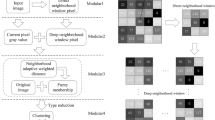Abstract
Clustering algorithms with deep neural network has attracted wide attention to scholars. A deep fuzzy K-means clustering algorithm model on adaptive loss function and entropy regularization (DFKM) is proposed by combining automatic encoder and clustering algorithm. Although it introduces adaptive loss function and entropy regularization to improve the robustness of the model, its segmentation effect is not ideal for high noise. The research purpose of this paper is to focus on the anti-noise performance of image segmentation. Therefore, on the basis of DFKM, this paper focus on image segmentation, combine neighborhood median and mean information of current pixel, introduce neighborhood information of membership degree, and extend Euclidean distance to kernel space by using kernel function, propose a dual-neighborhood information constrained deep fuzzy clustering based on kernel function (KDFKMS). A large number of experimental results show that compared with DFKM and classical image segmentation algorithms, this algorithm has stronger anti-noise robustness.































Similar content being viewed by others
References
Yeganejou M, Dick S (2018) Classification via deep fuzzy c-means clustering.? 2018 IEEE Int. Conf. Fuzzy Syst. (FUZZ-IEEE), pp 1–6. https://doi.org/10.1109/FUZZ-IEEE.2018.8491461https://doi.org/10.1109/FUZZ- https://doi.org/10.1109/FUZZ-IEEE.2018.8491461IEEE.2018.8491461
Zhao Z, Zhao J, Song K, Hussain A, Qianqian D, Dong Y, Liu J, Yang X (2020) Joint DBN and Fuzzy C-Means unsupervised deep clustering for lung cancer patient stratification. Eng Appl Artif Intell 91:0952–1976. https://doi.org/10.1016/j.engappai.2020.103571https://doi.org/10.1016/j.engappai. https://doi.org/10.1016/j.engappai.2020.1035712020.103571
Caron M, Bojanowski P, Joulin A, Douze M (2018) Deep Clustering for Unsupervised Learning of Visual Features. Proceedings of the European Conference on Computer Vision (ECCV), pp 132C149
Xie J, Girshick R, Farhadi A (2016) Unsupervised deep embedding for clustering analysis. In: International conference on machine learning, pp 478C487
Li F, Hong Q, Bo Z (2018) Discriminatively boosted image clustering with fully convolutional auto-encoders. Pattern Recognit 83:161–173. https://doi.org/10.1016/j.patcog.2018.05.019
Wang X, Pan J, Chu S (2020) A Parallel Multi-Verse Optimizer for Application in Multilevel Image Segmentation. IEEE Access 8:32018–32030. https://doi.org/10.1109/ACCESS.2020.2973411
Yang J, Parikh D, Batra D (2016) Joint unsupervised learning of deep representations and image clusters. In: The IEEE Conference on Computer Vision and Pattern Recognition, CVPR. pp 5147C5156
Nguyen T-T, Wang H-J, Dao T-K, Pan J-S, Ngo T-G, Yu J (2020) A Scheme of Color Image Multithreshold Segmentation Based on Improved Moth-Flame Algorithm. IEEE Access 8:174142–174159. https://doi.org/10.1109/ACCESS.2020.3025833
Fard MM, Thonet T, Gaussier E (2020) Deep k-Means: Jointly clustering with k-Means and learning representations. Pattern Recogn Lett 138:185–192. ISSN 0167-8655. https://doi.org/10.1016/j.patrec.2020.07.028https://doi.org/10. https://doi.org/10.1016/j.patrec.2020.07.0281016/j.patrec.2020.07.028
Zhang R, Li X, Zhang H, Nie F (2020) Deep Fuzzy K-Means With Adaptive Loss and Entropy Regularization. IEEE Trans Fuzzy Syst 28(11):2814–2824. https://doi.org/10.1109/TFUZZ.2019.2945232https://doi.org/10.1109/TFUZZ. https://doi.org/10.1109/TFUZZ.2019.29452322019.2945232
Yang M, Tsai H (2008) A Gaussian kernel-based fuzzy c-means algorithm with a spatial bias correction[J], vol 29. https://doi.org/10.1016/j.patrec.2008.04.016https://doi.org/ https://doi.org/10.1016/j.patrec.2008.04.01610.1016/j.patrec.2008.04.016
Ahmed MN, Yamany SM, Mohamed N, Farag AA, Moriarty T (2002) A modified fuzzy c-means algorithm for bias field estimation and segmentation of MRI data. IEEE Trans Med Imaging 21 (3):193–199. https://doi.org/10.1109/42.996338
Chen S, Zhang D (2004) Robust image segmentation using FCM with spatial constraints based on new kernel-induced distance measure. IEEE Trans Syst 8(4):1907–1916. https://doi.org/10.1109/tsmcb.2004.831165https://doi.org/10. https://doi.org/10.1109/tsmcb.2004.8311651109/tsmcb.2004.831165
Chen S, Zhang D (2004) Robust image segmentation using FCM with spatial constraints based on new kernel-induced distance measure. IEEE Trans Syst Man Cybern Part B (Cybern) 34:1907–1916. https://doi.org/10.1109/tsmcb.2004.831165
Kiyotaka HI, Honda K (2001) Fuzzy c-Means Clustering with Regularization by KL Information
Gharieb RR, Gendy G (2014) Fuzzy C-means with a local membership kl distance for medical image segmentation. 2014 Cairo International Biomedical Engineering Conference (CIBEC), pp 47–50. https://doi.org/10.13176/11.605
Quanhua Z, Shuhan J, Jun G, Xin G (2019) Fuzzy clustering image segmentation combined with membership space constraint[J]. Sci Surve Mapping 44(05):164–170
Guo Y, Abdulkadir S (2012) A novel color image segmentation approach based on neutrosophic set and modified fuzzy c-means. Circ Syst Signal Process 32(4):1699–1723. https://doi.org/10.1007/s00034-012-9531-xhttps://doi.org/10. https://doi.org/10.1007/s00034-012-9531-x1007/s00034-012-9531-x
Ahmed MN, Yamany SM, Mohamed N, Farag AA, Moriarty T (2002) A modified fuzzy C-means algorithm for bias field estimation and segmentation of MRI data. IEEE Trans Med Imaging 21 (3):193–199
Chang HH, Zhuang AH, Valentino DJ et al (2009) Performance measure characterization for evaluating neuroimage sSegmentation algorithms. NeuroImage 47(1):122–135
Martin D, Fowlkes C, Tal D, Malik J (2001) A database of human segmented natural images and its application to evaluating segmentation algorithms and measuring ecological statistics. Proceedings of the IEEE International Conference on Computer Vision 2 (2):416–423. https://doi.org/10.1109/ICCV.2001.937655
Acknowledgements
This work was supported in part by the National Natural Science Foundation of China (61671377), the Shaanxi Natural Science Foundation of China (2021JM-459). The authors are thankful to the anonymous reviewers for their constructive suggestions to improve the overall quality of this paper.
Author information
Authors and Affiliations
Corresponding author
Ethics declarations
Conflict of Interests
The authors declare that they have no known competing financial interests or personal relationships that could have appeared to influence the work reported in this paper.
Additional information
Publisher’s note
Springer Nature remains neutral with regard to jurisdictional claims in published maps and institutional affiliations.
Rights and permissions
About this article
Cite this article
Lei, L., Wu, C. & Tian, X. Robust deep kernel-based fuzzy clustering with spatial information for image segmentation. Appl Intell 53, 23–48 (2023). https://doi.org/10.1007/s10489-022-03255-3
Accepted:
Published:
Issue Date:
DOI: https://doi.org/10.1007/s10489-022-03255-3




